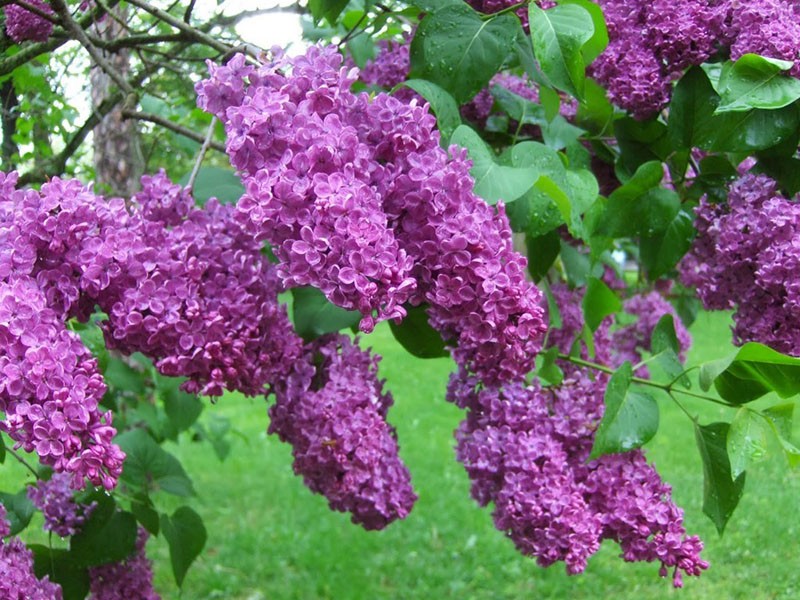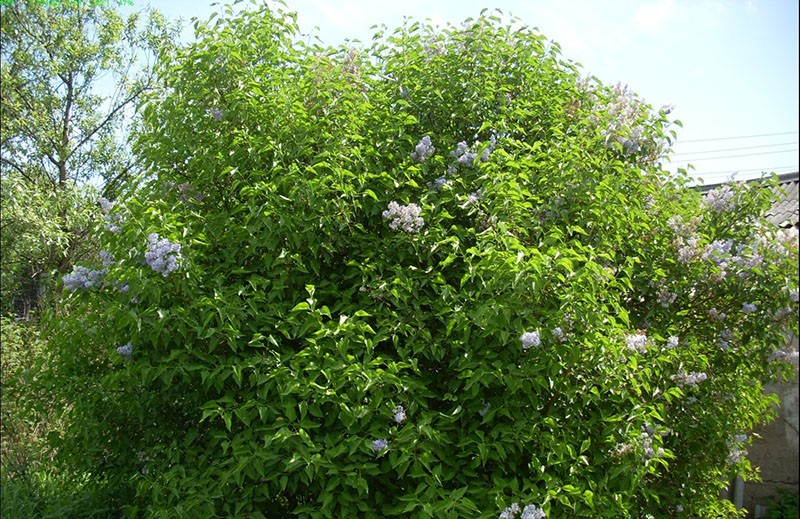Why lilacs don't bloom - find out the causes of the problem
 Bright and fragrant lilac is one of the main spring decorations of the infield. There are a number of reasons why lilacs do not bloom, because the lack of flowering is a problem that many gardeners face. Elimination of these factors allows you to restore the vegetative properties of the plant and get a lush and long-lasting lilac bloom.
Bright and fragrant lilac is one of the main spring decorations of the infield. There are a number of reasons why lilacs do not bloom, because the lack of flowering is a problem that many gardeners face. Elimination of these factors allows you to restore the vegetative properties of the plant and get a lush and long-lasting lilac bloom.
What time of year does lilac bloom

Most of the popular varieties of lilacs bloom in the first half of May. These include Persian, Ordinary, Hungarian. Species such as Chinese lilac bloom only towards the end of May or early June. To enjoy the fragrant fragrance in summer, you can plant the Amur lilac variety, which blooms later than the rest - in mid or late July.
For which year the lilac blooms depends on many factors. Young bushes from grafted seedlings can become covered with inflorescences the next year after planting, but they are best removed - this will help the plant maintain vitality. Bushes grown from cuttings, cuttings or seeds bloom only 4-6 years after planting.
Lilac does not bloom - the main reasons
 Most often, lilacs do not bloom due to mistakes made during planting, as well as mistakes when growing a shrub. Novice gardeners do not know how much fertilizing and watering a plant needs, which leads to a lack of flowering.
Most often, lilacs do not bloom due to mistakes made during planting, as well as mistakes when growing a shrub. Novice gardeners do not know how much fertilizing and watering a plant needs, which leads to a lack of flowering.
Why lilacs don't bloom - common reasons:
- unsuitable soil composition;
- wrong landing site;
- insufficient lighting;
- incorrect trimming;
- disease and insect pests.
The reason for the lack of flowering of lilacs can be a lack or excessive amount of fertilizers, especially nitrogen-containing dressings.
Unsuitable soil composition
 Despite the fact that lilac is considered an unpretentious crop, it has several requirements for the composition of the soil. For growing shrubs, it is best to use areas with light, sandy loam or peat soil.
Despite the fact that lilac is considered an unpretentious crop, it has several requirements for the composition of the soil. For growing shrubs, it is best to use areas with light, sandy loam or peat soil.
Basic requirements for soil:
- average humidity level;
- neutral acidity of the soil;
- the location of groundwater is not higher than 1.4-1.7 m to the earth's surface.
It is especially dangerous to plant lilacs in areas with heavy, waterlogged and acidic soil.
In this case, you can use ash, lime or dolomite flour to deoxidize it. But most often the effect obtained is not enough for planting lilac bushes.
Wrong location and lack of lighting
 One of the most common reasons that lilacs do not bloom is the wrong place to grow it, too windy or shaded.
One of the most common reasons that lilacs do not bloom is the wrong place to grow it, too windy or shaded.
In order to ensure active growth and long-term flowering of the shrub, you need to take into account the basic rules for choosing a site:
- for planting lilacs, it is advisable to choose areas of the garden from the east or west side, which are well lit by the sun for most of the day;
- the place for lilacs must be protected from wind and drafts;
- it is best to choose places for landing holes on plains or gentle slopes.
 If, after 1-2 years after planting, the lilac bushes have not begun to bloom, most often the reason lies in insufficient lighting.
If, after 1-2 years after planting, the lilac bushes have not begun to bloom, most often the reason lies in insufficient lighting.
Lilac is a light-loving crop, so when planting under a house or in the shade of tall trees, there is a risk that the flowering period will not start.
Errors when planting lilacs
 If serious mistakes were made during the planting of lilacs, this negatively affects the development of the plant, slows down the appearance of flower buds and leads to a weakening of the root system of the shrub.
If serious mistakes were made during the planting of lilacs, this negatively affects the development of the plant, slows down the appearance of flower buds and leads to a weakening of the root system of the shrub.
What to do to make the lilac bloom during planting:
- The most important condition for the development and flowering of the shrub is good drainage. Prepare planting holes up to 50 cm deep, fill the bottom of each with a layer of drainage material - this can be small pebbles, rubble or broken brick.
- Pour a mixture of 350 g of ash, 35 g on top of the drain superphosphate and 25 kg of humus.
- Pay particular attention to the grafting site of the young seedling. It cannot be covered with soil, it should be located about 5 cm above the ground level.
- After that, water the young bush generously at the root.
- When the water is completely absorbed, mulch the area of the trunk circle. The mulch layer should be at least 4-6 cm.

The optimal timing for planting lilac bushes is spring, when the buds have not yet blossomed, or the summer months, after flowering is complete. It is advisable to start planting work in cloudy weather or in the evening, after sunset.
Excess or lack of feeding
 Deficiency of nutrients and their excess negatively affect the flowering of lilacs. If the bushes begin to fatten, that is, release new shoots, but do not form flowers, this indicates an excessive amount of nitrogen-containing fertilizers.
Deficiency of nutrients and their excess negatively affect the flowering of lilacs. If the bushes begin to fatten, that is, release new shoots, but do not form flowers, this indicates an excessive amount of nitrogen-containing fertilizers.
When growing lilacs, it is very important to observe the fertilization rates. It is advisable to apply fertilizing with nitrogen content only 2-3 years after planting the shrub. To do this, in April or May, 60-70 g of urea or 70-80 g of ammonium nitrate is applied under each bush.
In the event of signs of an excess of nitrogen, such dressings should be carried out less often, no more than 1 time in 2 years.
Incorrect cropping
 An important role in stimulating the flowering of lilacs is played by its correct pruning. This procedure cannot be carried out in the autumn months, since cutting off excess shoots will lead to delayed bud formation and next year the lilac bush may simply not bloom.
An important role in stimulating the flowering of lilacs is played by its correct pruning. This procedure cannot be carried out in the autumn months, since cutting off excess shoots will lead to delayed bud formation and next year the lilac bush may simply not bloom.
How to make lilacs bloom - it is best to prune the shrub in early spring, before the buds swell. Remove any loose and dry shoots. Overgrowth can be removed throughout the year by cutting off the shoots with a shovel at ground level.
 Once every 3-4 years, lilac bushes require rejuvenation. To do this, cut out all the shoots that grow inside the lilac or thicken its crown, as well as old branches. To prevent infection from getting inside the wound surfaces, they need to be lubricated with oil paints or garden varnish.
Once every 3-4 years, lilac bushes require rejuvenation. To do this, cut out all the shoots that grow inside the lilac or thicken its crown, as well as old branches. To prevent infection from getting inside the wound surfaces, they need to be lubricated with oil paints or garden varnish.
Immediately after flowering, you need to cut off all drying inflorescences. Leaving them will cause the seeds to ripen and weaken the shrub noticeably.
Disease and insect damage
 A lilac bush, affected by diseases or pests, will not please with lush and long flowering.
A lilac bush, affected by diseases or pests, will not please with lush and long flowering.
Common problems when growing lilacs:
- Fungal lesions. They can be identified by the appearance of spots of various shapes and sizes on the leaves of the shrub, the fall of foliage and inflorescences. To prevent further spread of the fungus, cut and burn all affected leaves and branches. And treat the lilac with copper preparations.
- Late blight - signs are brown spots on the bark of lilacs, as well as the lack of bud opening and flowering. Remove and burn the affected areas of the bush, spray the bush with Bordeaux liquid.
- Nematodes - when lilacs are damaged by nematodes, the root system dies, shoots, leaves and inflorescences begin to dry out and fall off.The fight against nematodes is carried out using special chemicals.
In order for lilac bushes to please with lush and long flowering, you need to provide the plant with good care, as well as eliminate all mistakes that negatively affect the inflorescences. This will help transform lilacs into a vibrant and colorful garden decoration.